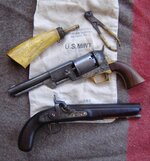During my hiatus from firearms, I developed a strong hobby in woodworking. The idea of building a firearm is very appealing to me (would have to find a gunsmith to do the metalwork for me)...and what better than a set of dueling pistols?
My first inclination is to do something to pair the set - like using ebony for one and white oak for the other (or a myriad of other combinations). I'm currently looking at this task as if any particular wood can be used...but is that true? Are there stresses placed on it that would make any species better than others?
If you know about it in enough detail, I'd love to hear from you. And if you don't, perhaps let me know what types of wood have been used to build the firearms that you've used? Additionally, all of the pistols that I've seen have a relatively similar shape. Are there delineations in design that you'd recommend I research?
Thank you!
My first inclination is to do something to pair the set - like using ebony for one and white oak for the other (or a myriad of other combinations). I'm currently looking at this task as if any particular wood can be used...but is that true? Are there stresses placed on it that would make any species better than others?
If you know about it in enough detail, I'd love to hear from you. And if you don't, perhaps let me know what types of wood have been used to build the firearms that you've used? Additionally, all of the pistols that I've seen have a relatively similar shape. Are there delineations in design that you'd recommend I research?
Thank you!













